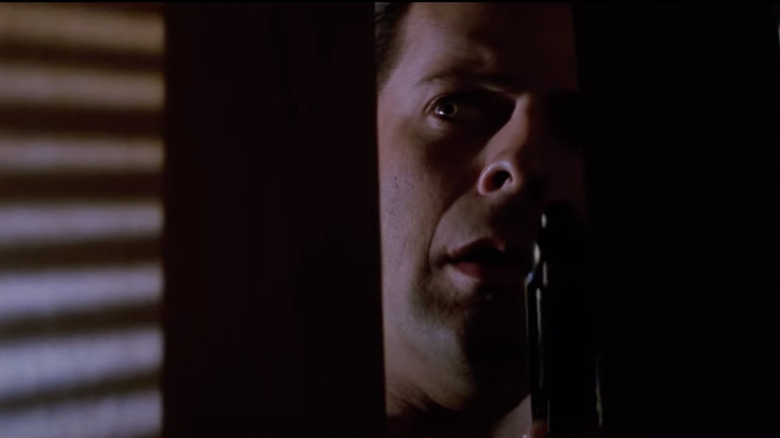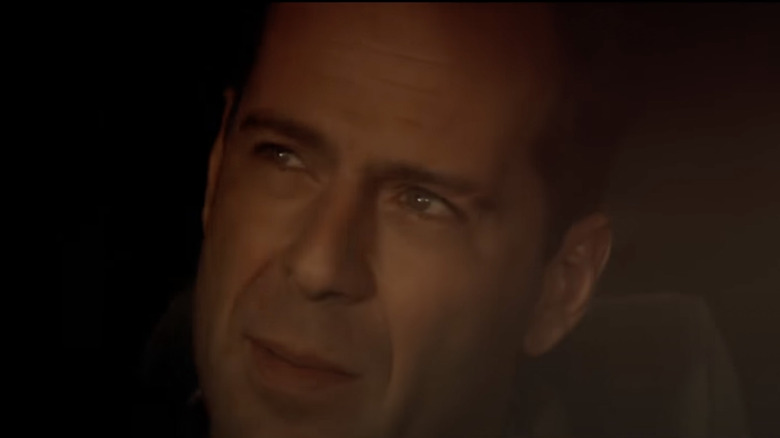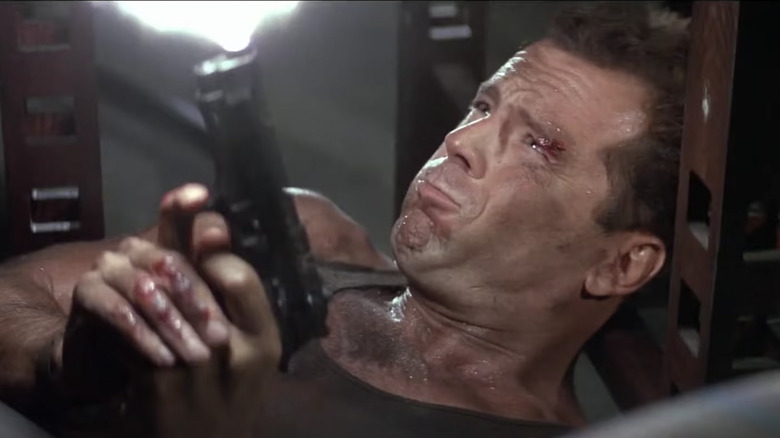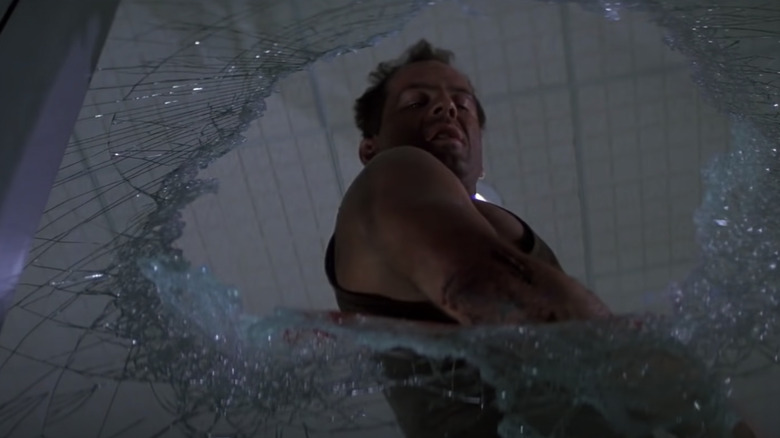
Let's go ahead and get this out of the way, "Yippee-ki-yay, mother f*****!"
"Die Hard" was kept on regular rotation in my childhood home. It was one of my dad's favorites, along with "Road House" and "Fire Down Below." To me, Bruce Willis has always been the kind of guy to blow up elevator shafts with C4 and a computer monitor or propel down a massive building with a fire hose around his waist, but that's far from the image he had in the early '80s.
Before he was cast as the smart-a**, roof jumping cop John McClane, Willis was known for two things: being a wise guy in the comedy show "Moonlighting," and cringy Seagrams commercials like this one. Not exactly the tough guy modern audiences are used to.
According to Netflix's "The Movies That Made Us," when Bruce Willis' face and name came up in the trailer for a serious action movie, people laughed. But he would prove the naysayers and chuckleheads wrong.
After "Die Hard," the actor would be one of Hollywood's most famous action stars and a little more hard of hearing.
'John Wayne? Rambo? Marshal Dillon?'

Few people pull off the jaded, sarcastic hero like Willis, and this was our first taste of that persona from him. Joel Silver's excessive use of explosions could make Michael Bay blush, but we all know audiences love a good boom in action flicks. It was also our introduction to Alan Rickman, who had only done stage work up until that point. All these factors made "Die Hard" a massive hit that forever redefined the action hero.
Before the hostage situation in Nakatomi Plaza, action stars rippled with steroid-aided muscles as they sauntered toward extinction-level danger with no regard for their own personal safety. Think Arnold in "Predator" or Stallone in "Rambo." If you're ever in need of saving, that's the type of guy you want to see rounding the corner. Not the guy known for dancing around a porch, singing to a dog about how much he loves wine coolers.
Netflix revealed that a lot of famous stars were offered the McClane role: Clint Eastwood, Stallone, Schwarzenegger, Richard Gere, the list goes on and on. Co-writer Steven E. de Souza said they all passed on the role because they thought the character was "a wimp ... [because all he] does is try to hide and get help." What kind of hero is that?
A relatable one.
John McClane was very different from the larger-than-life heroes audiences had become accustomed to. He was just a regular guy trying to make up with his wife, who stumbled into a hostage situation. He bleeds, he loses his temper, he gets scared, he even gets fooled by the villain. He isn't invincible or above calling for help.
Personally, I'd still prefer Schwarzenegger or Stallone to come to my rescue, but it would probably be fun to hurl sarcastic remarks at the bad guys with Willis as we both scurry away. The wise-cracking, know-it-all personality is what audiences loved about "Die Hard" and John McClane, and it's why the character and franchise became so successful.
"Die Hard" changed a couple of things for Bruce Willis. He became an accepted and celebrated action star and went from embarrassing Seagrams commercials to the highest-paid actor in Hollywood, but the after-effects weren't all good. The film also left Willis nearly deaf in his left ear.
'All You Gotta Do Is Pull The Trigger'

Like any workplace, film sets can be dangerous, and the potential for injury increases when guns are involved. While misfires or mistaking blanks for actual bullets are probably the most devastating kind of mistake, the sheer volume that results from shooting prop guns can also result in injury.
It's rumored that director John McTiernan "used extra loud blanks" in the "Die Hard" guns to produce a more realistic and dramatic sound. This was a fine decision for scenes that took place in open rooms or outside, but not so great in confined spaces, as Willis found out.
In an interview with The Guardian, Willis revealed he "suffer[s] two-thirds partial hearing loss in [his] left ear." He directly relates the loss of hearing to "an accident on the first 'Die Hard.'" His daughter, Rumer, added a little more detail about the mishap, explaining, "he shot a gun off next to his ear," reportedly while filming this scene. Turns out, shooting extra loud blanks next to his ear while pinned under a table wasn't a great decision for his eardrum.
Willis hasn't gone into detail about the events that led up to the injury, so we don't know if earplugs weren't available or if he decided not to use them. Either way, by the end of filming, the actor suffered irreparable damage to his left ear.
Willis isn't the only star to experience hearing problems related to film work. In fact, the lack of proper precautions leading to permanent hearing damage for actors is a rampant problem.
'Welcome To The Party, Pal'

There are a lot of rules for film productions, including mandating ear protection when working around gunfire or other loud noises, but enforcement of the rules is pretty substandard. I've been on sets where weapons have been used, and while ear protection is usually offered, it is generally left up to individuals to ensure they actually wear them. This lax enforcement of safety precautions has led to many actors losing their hearing.
An explosion on one of the "Star Trek" movie sets left William Shatner and Leonard Nimoy both suffering from "ringing in [their] ears" that never went away. While filming "All is Lost," Robert Redford developed "a severe ear infection" after spending many filming days with hoses dumping water into his ears. This would eventually result in the loss of "60 percent of [the] hearing in his left ear." Keifer Sutherland says he's "pretty much deaf in one ear and half deaf in the other" after years of exposure to guns and explosions on set.
Tragedies like the one that occurred on "Rust," which resulted in the death of cinematographer Halyna Hutchins, draw a lot of attention, and rightfully so. Misfires or mistaking live rounds for blanks are huge safety issues and worth discussing, but the issues of hearing damage resulting from gunfire or special effects seems to be widely overlooked in Hollywood, especially when filming action flicks.
Why?
Maybe because even after characters like John McClane, portraits of invincible heroes like Schwarzenegger and Stallone still linger in the back of our minds.
While guys like Arnold or Sly are no longer the only accepted form of action hero, they are still the ones I'd want to be saved by, and the hardest for other actors to live up to. If Willis and other Hollywood action stars feel like they have to compete with the images of Rambo or Dutch, they might feel the need to prove they're tough guys, real-life action heroes, the kind of men that don't get laughed at when their face comes up in the trailer for an action movie.
Rumer touched on this idea when she spoke to The Toronto Sun about her dad, saying "I think he just has this vibe where he feels like he's [got to be the] cool man."
And cool men don't need no stinkin' ear protection.
Read this next: The 14 Greatest Action Movies Of The 21st Century
The post The Die Hard Stunt That Left Bruce Willis Partially Deaf appeared first on /Film.
0 Commentaires